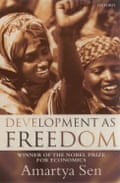WW Rostow: The Stages of Economic Growth: A Non-Communist Manifesto (1960)

One of the key questions in development is, can all countries become rich, and if so, how? Rostow, a US academic and adviser to JFK, rising to national security adviser to President Lyndon Johnson in the mid 1960s, said they can.
Openness to world markets and investment, state investments in infrastructure and new technologies, and ploughing profits back into industry, Rostow argued, would generate a self-sustaining growth, leading developing countries towards a US-style age of mass consumption. They would just have to modernise by overcoming tradition and custom, and embrace continuous growth.
Rostow saw modernisation’s complications, warning that the sense of loss among some of the population could be a dangerous moment. Communists could, he argued, try to hijack the process to impose their own form of development.
Rostow alluded to communists as “scavengers” and to communism as a “disease of the transition”. The US, he argued, had to establish alliances with developing country elites to facilitate modernisation, while eliminating this threat.
Rostow played a significant role in escalating the US war in Vietnam, which he saw as a necessity to eliminate the communist menace. Mass death was a price worth paying for the country’s modernisation.

Thirty years after Rostow’s book, the communist threat ceased to exist and capitalist globalisation now extends to every corner of the globe. Yet about half of the world’s population still live below the World Bank’s poverty threshold.
Rostow’s affirmative answer to whether or not all countries can become rich was, in hindsight, more pro-American ideology than a convincing explanation of the complexities of modern development.

Vandana Shiva: The Violence of the Green Revolution: Third World Agriculture, Ecology and Politics (1991)
By 2050, the world’s population is estimated to reach almost 10 billion. So how do we feed ourselves?
The answer proposed by, among others, the UN’s Food and Agriculture Organization, is through technology – large-scale irrigation, new seed varieties, improved machinery and chemical inputs – to raise agricultural productivity.
It is expected that this rural development will reduce hunger and the conflicts arising from it and will strengthen rural labour markets and social peace.
This is the green revolution model of agriculture, first rolled out in Mexico in the 1940s and 1950s, and then across parts of Asia and Latin American from the 1960s onwards. Today, international institutions want to apply it across sub-Saharan Africa.
Vandana Shiva – an Indian scholar and environmentalist – is warning about the dangers of technologically-based development from the top down. Her book is a study of the green revolution in India’s northern state of Punjab. By the 1980s, Punjab was India’s most prosperous state, but also home to the largest number of killings in independent India. Why?

In the 1970s, Punjab invested heavily in massive regional irrigation systems. It subsidised farmers’ switch from traditional to high-yield new grain varieties. Production rose and the region became a net grain exporter – but at a cost. Shiva says “control over nature and control over people were essential elements of the centralised and centralising strategy of the Green Revolution”.
Farmers became dependent upon the state and on agrochemical companies. Compared with traditional grains, high-yield varieties demand increasing amounts of fertilisers and water.
Increased fertiliser application reduced soil quality, requiring yet more fertiliser. Production costs increased, and when the central government withdrew subsidies, profits fell. Small farmers were marginalised by high and rising capital investment costs. Rural workers lost their jobs to new technologies.
Shiva documents how resource conflicts grew. Punjabi (predominantly) Sikh communities pitted against the central (predominantly) Hindu state, whom the former accused of unequally distributing water rights. It gave rise to a separatist movement.
Far from generating social peace and stronger labour markets, the green revolution in Punjab contributed to rural unemployment and violent conflicts.
Shiva’s book provides a stark warning of the dangers of placing our faith in new technologies that centralise power in the hands of states and agrochemical giants.
Karl Marx: Capital: A Critique of Political Economy (1867)

Over the past three years, £34tn of new wealth has been created. Its spread has been far from equal. Approximately £22tn, almost two-thirds of that wealth, has gone to the richest 1% of the world’s population, while the remaining 37%, about £13tn, has been distributed among the bottom 99%.
Marx, a German exile, lived in London during Britain’s Industrial Revolution and saw the simultaneous accumulation of great wealth and widespread poverty across Britain’s empire. He wanted to explain the world in order to change it to one without such inequalities.
Best known for the Communist Manifesto, written with Friedrich Engels, Marx portrayed capitalism’s novel economic dynamism and its generation of extreme inequalities. They called for a proletarian revolution.
In Capital, Marx explains how capitalism is rooted in the ever-greater polarisation between the haves and have-nots.
Marx makes two insights. While it is common to hear that capitalism represents an outgrowth of human nature, Marx detailed how it emerged through land theft, population displacement and the authoritarian subordination of these populations.

In England, land theft took place between the 15th and 17th centuries when an agrarian capitalist class arose by pushing peasants off the land. In the colonies of Africa, Asia and North and South America, populations were exterminated, enslaved, and land seized by new ruling classes.
This was the first act in establishing a grossly unequal world – where a small minority own the means of production, while the majority have nothing to sell but their labour.
The dominant bourgeois thought (of his time and ours) portrays the employment contract as a voluntary, mutually beneficial buying and selling of labour power. In Capital’s second insight, Marx shows capitalists use workers’ labour power to generate more value than its initial cost, and how powerful capitalists are then able to wrest much of that surplus value from less powerful capitalists through technological innovations.
These dynamics are an essential part of the inequality story.

Sylvia Federici: Caliban and the Witch: Women, the Body and Primitive Accumulation (2004)
The World Bank estimates that closing the gender gap so women could start and expand new businesses at the same ratio as men, would generate global economic gains of about $5-6tn (£4-4.75tn).
But why are women so heavily excluded from business activity in richer and poorer countries alike? And what could a book about medieval witch-hunts in Europe explain?
Federici, an Italian-American academic, feminist and founder of the international Wages for Housework campaign in the 1970s, provides a radical answer.
First published in 2004, her book explains how European witch-hunts were a way of excluding women from public life, while contributing to the rise of the modern wage-based economy.
Federici shows how primitive accumulation had different impacts on men and women. Previously, peasants worked the land as family units, exploited by local lords – handing him some of their produce or sometimes working for nothing. But they could pass on land tenure through the generations. Medical care – including contraception and abortion – was provided within and between households, often by older women.
Federici shows how alongside peasant dispossession and the evolution of the labour market, the modern economic order was built on the destruction of solidarity among peasant households. Lords and early modern states started this process by unleashing a wave of misogyny against peasant women.

Women who administered medical care to others – especially of birth-control – were branded witches and tortured to death. Women were increasingly confined to domestic, unpaid duties, and their labour devalued.
Federici documents how European colonialists branded women cannibals and witches to justify land grabs, enslavement and extermination. They enforced notions of women’s work being in the home.
The gruesome pre-history of the modern economic system was, Federici shows, heavily gendered and is part of the reason why divisions of labour exist today and are so disadvantageous to women.

Frantz Fanon: The Wretched of the Earth (1961)
In these disturbing times of social and economic inequalities, of rising violence and racism, Frantz Fanon’s 1961 book has a valuable response.
Fanon provides an explanation for the extreme racist conflict associated with capitalism and colonialism. He envisions a “new humanist” form of development, based on democratic equality and overcoming racism, patriarchy and inequality.
A Frenchman from Martinique, a radical psychiatrist and political philosopher, Fanon wrote The Wretched of the Earth during the closing stages of the Algerian revolution against French colonialism. From 1954, great numbers of poor Algerians fought the French settler state for which the murder of civilians, torture and the use of concentration camps was virtually official policy.
Fanon placed French colonial violence in a broader context of racist capitalism, describing how “deportations, massacres, forced labour and slavery were the primary methods used by capitalism to … establish its wealth and power”. For Fanon, racism was not only about exclusion from economic opportunities, it was about dehumanisation.
Fanon argued that the revolting Algerian peasantry could usher in a new humanist phase of development, but highlighted how national liberation movements were often captured by a new elite.

One reason for Fanon’s popularity among those seeking an alternative to top-down development is his insistence that, rather than attempting to emulate richer countries, “the underdeveloped countries must endeavour to focus on their very own values as well as methods and style specific to them”. While formal colonialism is gone, he shows how huge inequalities and racial and gender oppression persist.
His notion of development entailed overcoming class, gender and racial oppression. That “[w]omen shall be given equal importance to men, not in the articles of the constitution, but in daily life, at the factory, in the schools, and in assemblies”.
Fanon argued against aid. Rather, just as the post-Nazi German state was at that time paying reparations to Israel for the crimes of the Holocaust, so too he argued, should former colonial powers compensate their former subjects.
His book is about how racist violence was inherent to colonial capitalism and remains prescient, a vision of a new humanist form of development speaking loud and clear to our troubled times.

Alice Amsden: Asia’s Next Giant: South Korea and Late Industrialization (1989)
During the 1980s, economists said free trade would deliver rapid development. Privatising state-owned enterprises and banks, liberalising foreign trade and eliminating subsidies to domestic firms were all promoted.
Amsden – a Massachusetts Institute of Technology professor – helped shift thinking and policy towards recognising the importance of the state.
Asia’s Next Giant is an account of how, between the 1950s and 1980s, South Korea transformed its economy from an agrarian to a hi-tech industrial one.
The state exerted a high degree of control over private business to meet targets. Policies included import tariffs, subsidies and the provision of state assistance to selected firms, and control of bank-based finance, all commonplace across much of the world during the decades after the second world war.
What distinguished South Korea was the state’s ability to force firms to hit ambitious performance targets.
In Amsden’s phrase, the state “picked winners”. Firms that received subsidies had to export or their funds were cut off.
Few today have heard of Taihan group – an early electronics producer. When it failed to expand, the government transferred ownership to the now world-renowned Daewoo Electronics.
The state used industrial licences to control which firms entered new industries, and controlled financing through ownership of commercial banks.

It controlled prices for electricity, steel, chemicals, gas and synthetic fibres. Keeping prices of inputs low helped companies plough more of their revenues into research and development.
In terms of industrial transformation, it was a great success. But it was delivered under dictatorship, with minimal labour rights and some of the world’s longest working hours.
Does this mean we need to throw out the industrial policy baby with the dictatorial anti-labour bathwater? It needn’t, but the challenge instead is to combine industrial policy with enhanced democracy that favours the majority.

Naila Kabeer: Reversed Realities: Gender Hierarchies in Development Thought (1994)
In a world where 252 men have more wealth than one billion women in Latin America, the Caribbean and Africa combined, is gender equality possible?
London School of Economics professor of gender, Kabeer argues against the assumption of “smart economics” that women can and should be like men. She argues for win-win solutions to economic growth and empowering women.
Smart economics holds that gender equality is good for women, and boosts economic growth. These two “wins” are self-reinforcing. In Reversed Realities, Kabeer provides reasons why this is not that smart.
She argues that the assumption that, freed from sexist cultural and legal norms, women can participate as equals to men in the economic market, ignores biological differences. Giving birth and nursing babies has significant implications in a modern economy.
So, too, the notion of the modern man (homo economicus), which women are supposed to aspire to, is a fiction. Men’s ability to act as rational, individual economic actors – choosing what work to undertake and how to use their income – is not self-supporting.
Kabeer says women’s home labour “relieves men of the tasks associated with maintaining both their own bodies and the domestic locations where such maintenance takes place, thereby freeing them to behave ‘as if’ they were indeed the disembodied rational agents of liberal theory”.

As long as most “care work” – which underpins men’s ability to “go out to work” to earn money – is unpaid and undertaken by women, there can be no gender equality.
As women enter the labour force in developing countries in increasing numbers, men don’t do greater amounts of care work. Women just endure a “double-burden”.
If the objective is for women becoming more like men, through legal reform and greater labour market participation, why, this book asks, is men being “as good as women” not “an important consideration”?

Amartya Sen: Development as Freedom (1999)
One of the most powerful truisms that politicians, policymakers and academics buy into is that development depends upon economic growth.
Sen – an Indian economist and Nobel prizewinner – makes a compelling argument about why that narrative is wrong.
Many countries achieved rapid growth and industrial transformation during the late 20th and early 21st centuries. The most prominent – Brazil and South Korea in the 1960s and 1970s, and contemporary China – under authoritarian regimes.
Authoritarianism is justified by some as necessary for an ultra-hardworking labour force to catch up with developed countries. Sen argues that human development could and should be “a process of expanding the real freedoms” people enjoy.
Democracy, political participation and freedom of speech ensure that the poor cannot simply be ignored or exploited in the name of growth, he argues.
Core essential freedoms include a life free from the threat of starvation, undernourishment and premature mortality, alongside literacy and numeracy.
People’s freedoms are intrinsically important and enhance economic participation, generating further freedom-enhancing values.
States and public institutions have a crucial role to play. Sen’s thinking about development is evident in his understanding of poverty. He opposes metrics that count poverty based on income but focuses on ways in which poverty restricts freedom, and how it is expanded by anti-poverty measures.
Sen welcomed India’s National Rural Employment Guarantee Scheme of the early 2000s, which provided at least 100 days of unskilled wage employment a year to at least one member of every household, contributing significantly to poverty reduction.

The scheme enhanced its recipients’ “self-respect and participation in life and community” and he argues that women’s empowerment – through education, healthcare, changes to sexist laws – is key to women’s ability to advance social change.
“Nothing, arguably, is as important today in the political economy of development as an adequate recognition of political, economic and social participation and leadership of women,” he concludes.
"like this" - Google News
December 27, 2023 at 12:00PM
https://ift.tt/Jw39Tgb
How did the world get like this? Eight books to help explain the way we live now - The Guardian
"like this" - Google News
https://ift.tt/qBbHYwF
Shoes Man Tutorial
Pos News Update
Meme Update
Korean Entertainment News
Japan News Update
No comments:
Post a Comment